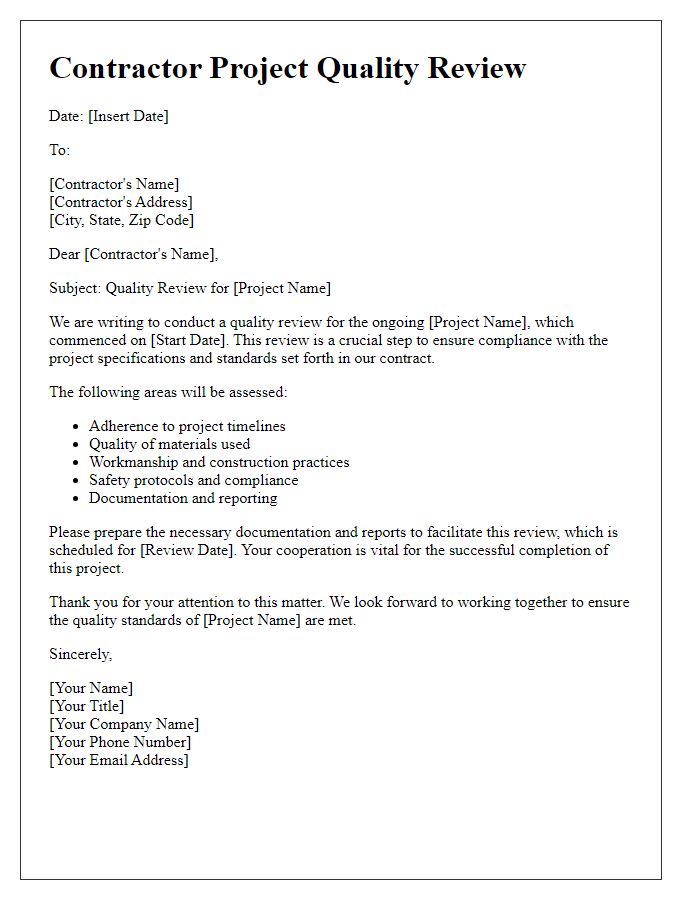Are you looking for a reliable way to ensure quality in your contractor projects? Crafting a well-structured letter can make all the difference in setting clear expectations and maintaining high standards. In this article, we'll explore essential elements to include in your project quality assurance letter and provide useful templates to get you started. Dive in to learn how you can enhance communication and quality control in your projects!

Project Scope and Deliverables
A well-defined project scope is crucial for successful quality assurance in contractor projects, clearly outlining the objectives, boundaries, and expectations. Deliverables include specific outcomes such as completed infrastructure elements, materials meeting industry standards, and documentation ensuring compliance with local regulations and client specifications. For instance, concrete must meet the minimum compressive strength of 4,000 psi for durability, while electrical systems must adhere to the National Electrical Code (NEC) to ensure safety and functionality. Regular inspections and audits during construction phases help identify discrepancies early, fostering accountability and maintaining project timelines. Ensuring all parties understand their roles, timelines, and quality benchmarks leads to a seamless workflow and minimizes potential delays or cost overruns.
Quality Standards and Compliance
Quality assurance is essential in contractor projects, ensuring adherence to established quality standards and compliance regulations, such as ASTM (American Society for Testing and Materials) and ISO (International Organization for Standardization). Implementing these standards is critical for maintaining structural integrity and durability in construction materials like concrete, asphalt, and steel. Regular inspections and assessments must be conducted throughout the project lifecycle at key milestones, including pre-construction, during construction, and post-completion, to verify quality adherence. Compliance documentation must be meticulously maintained, encompassing test results, inspection reports, and corrective action records to demonstrate accountability. Effective communication among stakeholders, including project managers, contractors, and clients at locations like construction sites in urban development areas, is vital to ensure all parties are aligned on quality expectations and requirements.
Inspection and Testing Protocols
Project quality assurance in construction involves a systematic approach to inspection and testing protocols, vital for ensuring compliance with industry standards. Key practices include establishing clear inspection criteria based on ASTM (American Society for Testing and Materials) guidelines. Regular site inspections during critical phases, such as concrete curing (28-day strength test), ensure that materials (like Portland cement) meet specifications. Testing protocols for structural components often involve non-destructive testing methods (e.g., ultrasonic testing for weld integrity), providing accurate assessments without causing damage. Documentation, including daily log reports, is crucial for tracking compliance and addressing potential issues swiftly. Engaging third-party inspectors can also enhance objectivity, ensuring adherence to project specifications outlined in the contract documents.
Roles and Responsibilities
Quality assurance in construction projects involves systematic processes to ensure that the finished structure meets specified standards. Key roles include the Quality Assurance Manager overseeing compliance with building codes and regulations, and Site Inspectors conducting regular checks on materials such as concrete and steel for quality standards. Project Managers coordinate with subcontractors, ensuring that their work aligns with project specifications and deadlines. Documentation Specialists maintain records of inspections, tests, and corrective actions, while Safety Officers enforce regulations (e.g., OSHA standards) to promote a safe working environment. Effective communication throughout the project lifecycle is crucial to address quality issues promptly, ensuring successful project completion.
Reporting and Documentation Procedures
Contractor project quality assurance involves meticulous reporting and documentation procedures to ensure adherence to industry standards. Detailed documentation includes the Quality Assurance Plan (QAP), outlining processes for inspections, testing, and compliance with specifications. Regular quality audits, adhering to ISO 9001 standards, involve systematic evaluations conducted weekly or bi-weekly. Inspection reports must detail findings from site visits, including compliance with safety regulations set by OSHA (Occupational Safety and Health Administration) and project-specific requirements. Non-conformance reports (NCRs) document any deviations from the project specifications, with corrective action plans (CAPs) developed within 48 hours. All records, including materials test reports, should be archived in a secure digital format for future reference, facilitating easier access during project evaluations or inspections.
Letter Template For Contractor Project Quality Assurance Samples
Letter template of Quality Monitoring Notification for Contractor Project

Letter template of Quality Assurance Improvement Recommendations for Contractors












Comments